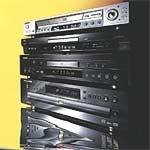Progressive Views: 4 Progressive-Scan DVD Players

When progressive-scan DVD players first emerged almost two years ago, the already excellent picture quality we'd come to expect from standard players suddenly got a whole lot better. That's because the new models could convert video signals to a progressive-scan format for display on a TV or monitor with progressive-scan capabilities. (Ordinary analog video is "interlaced," meaning that the scan lines making up each frame are presented alternately, while a progressive-scan display presents all the scan lines in sequence, resulting in a solid-looking image with less flicker.)
But the early progressive models were so pricey, they'd have seemed at home in a display case at Tiffany's. In the past year, one or two odd players leaked out in the $500 range, but they provided sub-par progressive-scan performance and generally weren't worth the extra money manufacturers asked for them. Now, like everything else related to DVD, progressive-scan players are proliferating and their prices are tumbling. To find out what level of performance you can expect today from players with this capability, we lined up a quartet of shiny new models and put them to the test.
We evaluated JVC's XV-S60BK ($349), Sony's DVP-NS700 ($349), and Yamaha's DVD-S1200 ($999) - all single-disc models - and the Marantz VC5200 ($650), a five-disc changer. The Yamaha can also play DVD-Audio discs, which accounts for its higher price. In addition to a progressive-scan video output with 2:3 pulldown - a feature that improves image quality even further by compensating for the difference between the 24 frames per second (fps) of film and the 30-fps rate of video - each model can play MP3 files recorded onto CD-R and CD-RW discs.
Since the focus of this test was progressive-scan video performance, all evaluations were made with the player's progressive-scan mode active and its component-video output connected to an HDTV monitor's wideband component-video input. Our Spotlight DVD-player report last issue ("DVD in the Fast Lane") proved that the standard performance from the interlaced composite- and S-video outputs of typical players is excellent even in models at very modest prices. But manufacturers of progressive-scan players use a wide range of chip sets to upconvert the interlaced video signal stored on DVDs to a progressive-scan format. For that reason, we've found that progressive-scan video quality can vary quite a bit among players.
- Log in or register to post comments






























































